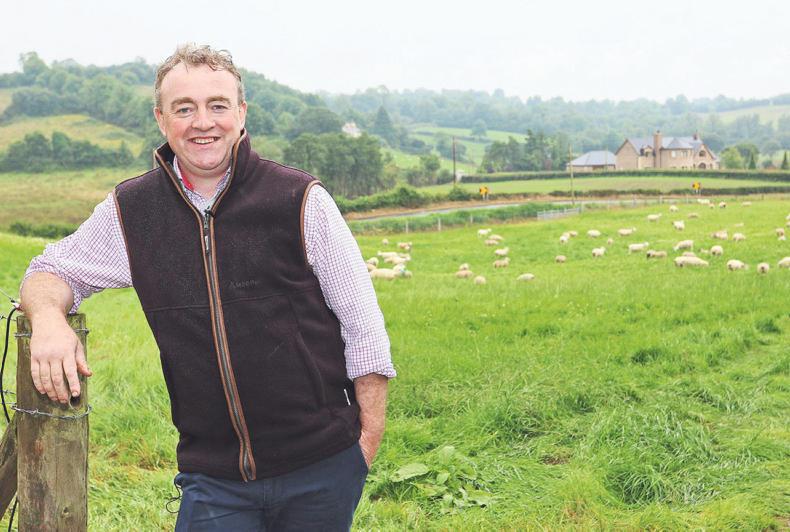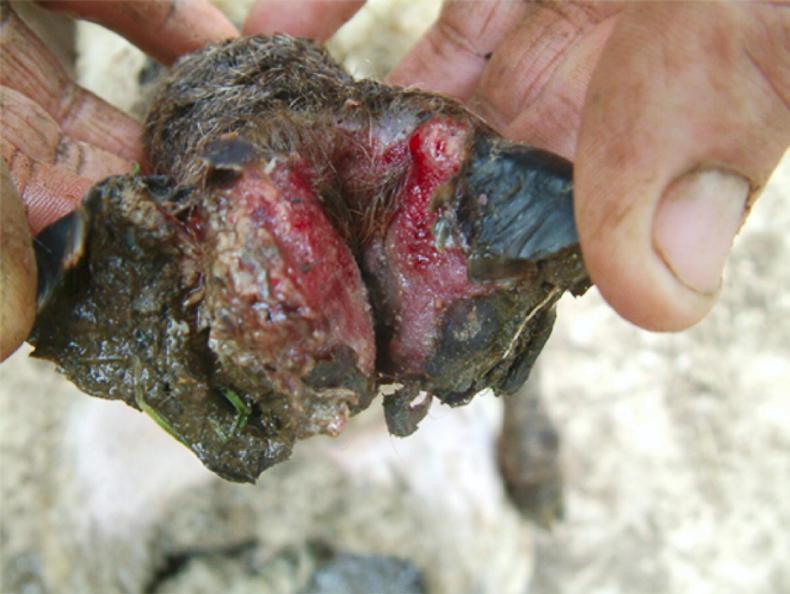This is the advice of Cavan veterinary practitioner Finbarr Kiernan who also runs his own sheep flock at Belturbet.
“Many farmers tolerate very high levels of lameness, with devastating impact on performance and profit, not to mention the massive drain on labour. It can result in a 15% drop in conception rate and up to a 20% reduction in lambing percentage. On top of that, up to 20% more lambs are sold as stores from lame ewes compared to sound ewes.
Footrot, the major cause of lameness, can affect 10% or more of sheep in most flocks every year. A recent Sheep Ireland survey showed a prevalence of up to 11% in ewes and 16% in lambs. A Royal College of Veterinary Surgeons report showed that 92% of UK flocks had varying levels of lameness,” said Finbarr.
Diagnosis
He said the first step in diagnosing lameness is to correctly identify the cause of the problem. Misdiagnosis and wrong treatment can often make the problem worse.
While footrot and scald are the most common contributors to lameness, there are a host of other conditions. These include contagious ovine digital dermatitis (CODD), strawberry foot, shelly hoof and abscesses. “It will pay to get your vet to carry out a detailed inspection, identify the bugs and prescribe the most effective treatment and control strategy,” he stressed.
In dealing with lameness on his clients’ farms, he uses a computer model developed at Reading University which, through integrating factors such as lamb price, cull ewe value and the cost of treatment, can accurately calculate the cost benefit of selected control strategies.
Vaccination
Finbarr uses vaccination on his own farm. Where used as part of a strategic control plan, it is very effective. There is just one vaccine licensed for the control of footrot. It is essential to vaccinate the entire flock. The initial course consists of two doses given six weeks apart. In flocks with constant lameness re-vaccination should take place at six monthly intervals.
The best time to vaccinate is about a month before the start of the breeding season or before sheep are housed.
Foot-trimming makes the problem worse
 “While trimming may make the foot look pretty, it can often cause more damage and delays healing,” said Dr Joe Angell, one of the leading experts on footrot in the UK.
“While trimming may make the foot look pretty, it can often cause more damage and delays healing,” said Dr Joe Angell, one of the leading experts on footrot in the UK.
Dr Angell, a veterinary practitioner in north Wales and an honorary research fellow at Liverpool University, highlighted research studies which showed that sheep that are trimmed and given a long-acting antibiotic in injection take longer to heal than those that were just given the antibiotic.
Finbarr described foot-trimming as a “compulsive disorder among some sheep farmers. It creates more problems and the disease lasts longer.”
Joe Angell said recent UK research indicates that footrot and scald, the major causes of lameness, are caused by the same bacteria. He also outlined the results of a study which showed that sheep with footrot were seven times more likely to get CODD.
Treatment
He stressed the importance of early treatment of lame sheep. “Every time a lame sheep takes a step a deposit of the bacteria is left behind. Use a spray containing antibiotic and a long-acting antibiotic injection. Sheep that are persistently lame are costing a lot of money and are spreading infection. They should be culled.”
He said footbathing techniques often leave a lot be desired. Sheep should be run through clean water before going through the footbath. They should be left standing in the bath for the recommended amount of time for the product that is being used and left on a clean, hard surface for at least half an hour to allow the chemical to soak in.
Hygiene
“Keeping handling areas as clean as possible is vital in avoiding spread. Use lime around collecting yards, races and creep feeders.
“When buying in sheep, the practice should be: off the trailer, into the footbath and then keep them separate from the main flock for 28 days. It will not eliminate the risk but will reduce it,” he advised.
He agrees with Finbarr Kiernan about the effectiveness of vaccination as part of an overall control strategy. “It is a decision that should be made in conjunction with your vet.”
Five-point footrot control plan
The following five point plan has been used successfully in the control of footrot on a number of farms in Britain.
1 Treat: all clinical cases should be effectively treated, including the use of an injectable antibiotic as well as a localised antibiotic spray. Any paring should be kept to the absolute minimum if done at all.
2 Avoid spread: footbathing sheep following handling can help reduce the spread of the disease. Spreading lime at gateways and around feed troughs can also be helpful.
3 Vaccinate: if footrot is affecting 5% of the flock, there can be a cost benefit in vaccinating the entire flock. There is one licensed vaccine available. Used as part of a strategic plan, it is highly effective. It also helps to reduce antibiotic use, an important consideration in the current climate of concern about over-use of antibiotics.
4 Cull: some sheep are chronic carriers and will not respond to treatment. They are a continuing source of infection and should be culled.
5 Quarantine: all lame sheep should be isolated from the flock and treated accordingly. Keep bought-in sheep separate for at least 21 days.
This is the advice of Cavan veterinary practitioner Finbarr Kiernan who also runs his own sheep flock at Belturbet.
“Many farmers tolerate very high levels of lameness, with devastating impact on performance and profit, not to mention the massive drain on labour. It can result in a 15% drop in conception rate and up to a 20% reduction in lambing percentage. On top of that, up to 20% more lambs are sold as stores from lame ewes compared to sound ewes.
Footrot, the major cause of lameness, can affect 10% or more of sheep in most flocks every year. A recent Sheep Ireland survey showed a prevalence of up to 11% in ewes and 16% in lambs. A Royal College of Veterinary Surgeons report showed that 92% of UK flocks had varying levels of lameness,” said Finbarr.
Diagnosis
He said the first step in diagnosing lameness is to correctly identify the cause of the problem. Misdiagnosis and wrong treatment can often make the problem worse.
While footrot and scald are the most common contributors to lameness, there are a host of other conditions. These include contagious ovine digital dermatitis (CODD), strawberry foot, shelly hoof and abscesses. “It will pay to get your vet to carry out a detailed inspection, identify the bugs and prescribe the most effective treatment and control strategy,” he stressed.
In dealing with lameness on his clients’ farms, he uses a computer model developed at Reading University which, through integrating factors such as lamb price, cull ewe value and the cost of treatment, can accurately calculate the cost benefit of selected control strategies.
Vaccination
Finbarr uses vaccination on his own farm. Where used as part of a strategic control plan, it is very effective. There is just one vaccine licensed for the control of footrot. It is essential to vaccinate the entire flock. The initial course consists of two doses given six weeks apart. In flocks with constant lameness re-vaccination should take place at six monthly intervals.
The best time to vaccinate is about a month before the start of the breeding season or before sheep are housed.
Foot-trimming makes the problem worse
 “While trimming may make the foot look pretty, it can often cause more damage and delays healing,” said Dr Joe Angell, one of the leading experts on footrot in the UK.
“While trimming may make the foot look pretty, it can often cause more damage and delays healing,” said Dr Joe Angell, one of the leading experts on footrot in the UK.
Dr Angell, a veterinary practitioner in north Wales and an honorary research fellow at Liverpool University, highlighted research studies which showed that sheep that are trimmed and given a long-acting antibiotic in injection take longer to heal than those that were just given the antibiotic.
Finbarr described foot-trimming as a “compulsive disorder among some sheep farmers. It creates more problems and the disease lasts longer.”
Joe Angell said recent UK research indicates that footrot and scald, the major causes of lameness, are caused by the same bacteria. He also outlined the results of a study which showed that sheep with footrot were seven times more likely to get CODD.
Treatment
He stressed the importance of early treatment of lame sheep. “Every time a lame sheep takes a step a deposit of the bacteria is left behind. Use a spray containing antibiotic and a long-acting antibiotic injection. Sheep that are persistently lame are costing a lot of money and are spreading infection. They should be culled.”
He said footbathing techniques often leave a lot be desired. Sheep should be run through clean water before going through the footbath. They should be left standing in the bath for the recommended amount of time for the product that is being used and left on a clean, hard surface for at least half an hour to allow the chemical to soak in.
Hygiene
“Keeping handling areas as clean as possible is vital in avoiding spread. Use lime around collecting yards, races and creep feeders.
“When buying in sheep, the practice should be: off the trailer, into the footbath and then keep them separate from the main flock for 28 days. It will not eliminate the risk but will reduce it,” he advised.
He agrees with Finbarr Kiernan about the effectiveness of vaccination as part of an overall control strategy. “It is a decision that should be made in conjunction with your vet.”
Five-point footrot control plan
The following five point plan has been used successfully in the control of footrot on a number of farms in Britain.
1 Treat: all clinical cases should be effectively treated, including the use of an injectable antibiotic as well as a localised antibiotic spray. Any paring should be kept to the absolute minimum if done at all.
2 Avoid spread: footbathing sheep following handling can help reduce the spread of the disease. Spreading lime at gateways and around feed troughs can also be helpful.
3 Vaccinate: if footrot is affecting 5% of the flock, there can be a cost benefit in vaccinating the entire flock. There is one licensed vaccine available. Used as part of a strategic plan, it is highly effective. It also helps to reduce antibiotic use, an important consideration in the current climate of concern about over-use of antibiotics.
4 Cull: some sheep are chronic carriers and will not respond to treatment. They are a continuing source of infection and should be culled.
5 Quarantine: all lame sheep should be isolated from the flock and treated accordingly. Keep bought-in sheep separate for at least 21 days.
 “While trimming may make the foot look pretty, it can often cause more damage and delays healing,” said Dr Joe Angell, one of the leading experts on footrot in the UK.
“While trimming may make the foot look pretty, it can often cause more damage and delays healing,” said Dr Joe Angell, one of the leading experts on footrot in the UK.









SHARING OPTIONS